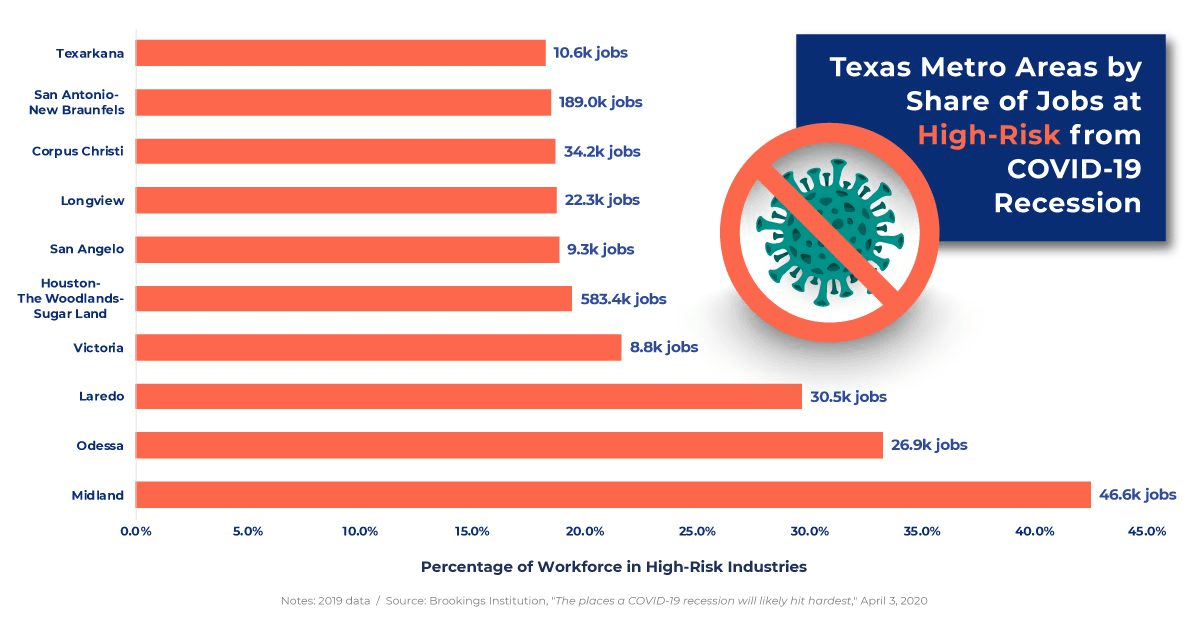The U.S Department of Labor updated their projections for unemployment claims and Texas numbers have been steeply rising, so it’s important to take a closer look at projections and data that might shed a light on which Texas jobs have been the most at risk.
The Texas Workers Impacted the Most by COVID-19

According to the Brookings Institution, a non-profit public policy organization, many Texans may face job uncertainty for the first time in years. That’s the result of not just the steep economic drop-off from the coronavirus and the collapse of oil prices, but also the prosperity that marked the Texas economy for years before now.
Brookings conducted research to show which workers would be most impacted by efforts to fight the spread of COVID-19, as well as the places across the country which might have the most jobs that are vulnerable to a recession. Several Texas communities — from Houston and Dallas to Midland and McAllen — ended up on their lists.
Brookings focused on workers in industries that have been hardest hit by the coronavirus over the past month — retail, passenger transportation, arts and entertainment, accommodation, restaurants and bars, and a variety of other personal services — as well as the energy workers affected by the oil price drop.
Here are the job losses that the most vulnerable Texas communities are facing:

Brookings notes that “retail, food service, and arts/entertainment have traditionally provided gateway jobs for younger people getting started in their careers, people working part time or seasonally, and people with lower levels of educational attainment. These industries face immediate risks from the pandemic, resulting in a set of vulnerable workers with a distinct demographic profile.”

Nationally, Brookings estimates that about 1 in 5 vulnerable workers are young (ages 18-24), 43% are employed part-time or seasonally, and 42% are have no more than a high school diploma.
These numbers demonstrate the need for federal stimulus funds in Texas, which will support greater unemployment compensation and pay eligible Texas taxpayers up to $1,200 for individuals, $2,400 for married couples, and $500 for each qualifying child.
This data also demonstrates the vital importance of creating an economic recovery plan for the state. Without sound planning that considers the demographics, skills and raw numbers vulnerable workers, too many families, small businesses, local governments and others will be left to fend for themselves.
Texas 2036 was created to provide a road map of policy initiatives that will propel Texas forward over the next 16 years. Our work has focused, in part, on factors that an economic recovery plan also will need to look at, including how well our state’s schools, health care system, workforce, infrastructure and government perform. We stand ready to help the state gather data and develop policy that a good recovery plan would require.

Texas has done this kind of planning before – with hurricanes, droughts and other downturns – but this challenge is unique in its widespread, far-reaching and unpredictable impacts on all aspects of our economy. Unfortunately, with COVID-19, there may never be an “all clear” siren — Texas will likely emerge from this crisis piece-by-piece over the next year, with some areas and industries beginning to recover before others. But if we wait to see how this crisis ends before we begin a comprehensive planning process, we will be too late.
By taking action now with our sights on the future, Texas could lead the way in getting ahead of the economic curve, laying the foundation for Texans to smartly get back to work and reenergize our economy.
